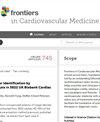A comparative study of the clinical benefits of rivaroxaban and dabigatran in patients with nonvalvular atrial fibrillation with high bleeding risk
IF 2.8
3区 医学
Q2 CARDIAC & CARDIOVASCULAR SYSTEMS
引用次数: 0
Abstract
ObjectiveRivaroxaban and dabigatran are approved to reduce the risk of stroke in patients with nonvalvular atrial fibrillation (NVAF). However, the clinical benefits of rivaroxaban and dabigatran in people with high bleeding risk are unclear.MethodsA retrospective study was conducted on NVAF patients admitted to the First Affiliated Hospital of Zhengzhou University from May 31, 2016 to May 31, 2019. These patients had a high risk of bleeding and were taking at least one study medication. The aim of the study was to evaluate clinical benefits by comparing the efficacy and safety risks of these two medicationsResultsA total of 1,301 patients with high bleeding risk were enrolled, including 787 patients in the rivaroxaban group and 514 patients in the dabigatran group. Results of the primary efficacy benefit endpoint were obtained from 104 patients (13.21%) in the rivaroxaban group and 81 (15.76%) patients in the dabigatran group [hazard ratio (HR): 0.860; 95% confidence interval (CI): 0.637–1.162;利伐沙班和达比加群对出血风险较高的非瓣膜性心房颤动患者临床疗效的比较研究
目的利伐沙班和达比加群经批准用于降低非瓣膜性心房颤动(NVAF)患者的卒中风险。方法对2016年5月31日至2019年5月31日郑州大学第一附属医院收治的非瓣膜性心房颤动(NVAF)患者进行回顾性研究。这些患者出血风险较高,且至少服用一种研究药物。研究的目的是通过比较这两种药物的疗效和安全风险来评估临床获益。结果共有1301例出血风险高的患者入组,其中利伐沙班组787例,达比加群组514例。利伐沙班组 104 名患者(13.21%)和达比加群组 81 名患者(15.76%)获得了主要疗效终点[危险比 (HR):0.860;95% 置信区间 (CI):0.637-1.162;P = 0.327],这表明达比加群和利伐沙班在预防高出血风险 NVAF 患者中风和全身性栓塞方面没有显著差异。利伐沙班组 49 例(6.23%)患者和达比加群组 36 例(7.00%)患者观察到了主要安全性终点(HR:利伐沙班组为 0.801;95% CI:0.512-1.255;P = 0.333),这表明在减少致命性出血和关键器官出血方面,利伐沙班和达比加群无显着差异。在次要疗效和获益终点方面,利伐沙班组和达比加群组分别有28例(3.56%)和26例(5.06%)患者死亡,HR分别为0.725(95% CI:0.425-1.238;P = 0.239);利伐沙班组有32例(4.07%)患者发生心肌梗死(MI);达比加群组有31例(6.03%)患者发生心肌梗死(MI),HR分别为0.668(95% CI:0.405-1.102,P=0.114),这表明达比加群和利伐沙班在预防全因死亡和心肌梗死方面没有显著差异。结论在出血风险较高的NVAF患者中,达比加群和利伐沙班在预防卒中和全身性栓塞方面没有显著差异。达比加群与利伐沙班在减少致命性出血和重要器官出血方面也无明显差异。
本文章由计算机程序翻译,如有差异,请以英文原文为准。
求助全文
约1分钟内获得全文
求助全文
来源期刊

Frontiers in Cardiovascular Medicine
Medicine-Cardiology and Cardiovascular Medicine
CiteScore
3.80
自引率
11.10%
发文量
3529
审稿时长
14 weeks
期刊介绍:
Frontiers? Which frontiers? Where exactly are the frontiers of cardiovascular medicine? And who should be defining these frontiers?
At Frontiers in Cardiovascular Medicine we believe it is worth being curious to foresee and explore beyond the current frontiers. In other words, we would like, through the articles published by our community journal Frontiers in Cardiovascular Medicine, to anticipate the future of cardiovascular medicine, and thus better prevent cardiovascular disorders and improve therapeutic options and outcomes of our patients.
文献相关原料
| 公司名称 | 产品信息 | 采购帮参考价格 |
|---|
 求助内容:
求助内容: 应助结果提醒方式:
应助结果提醒方式:


